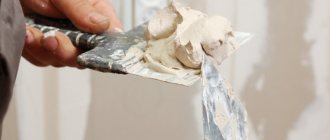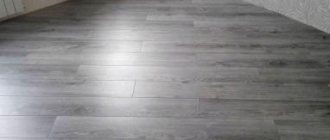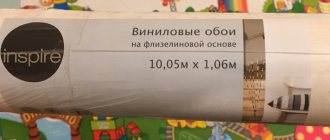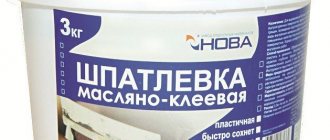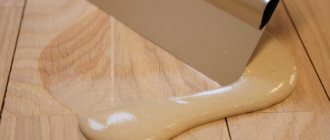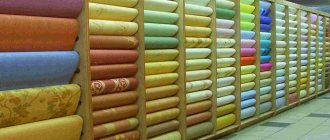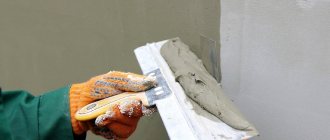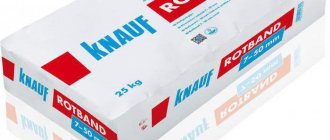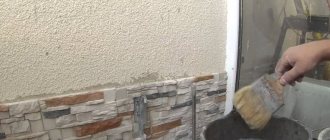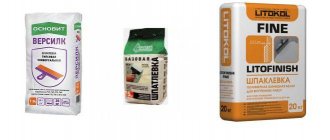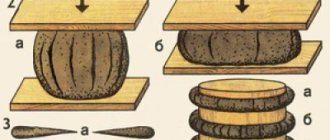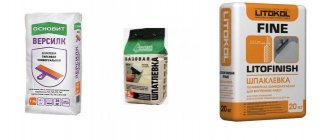Rotband is a brand of building materials that is chosen by both professionals and home craftsmen. All products, including Rotband putty, were developed by German specialists. The production technology took into account the difficult Russian operating conditions. Therefore, the finish serves for a long time without complaints.
History of the Knauf company
The Knauf company was born in 1932 in Germany. It was invented by the Knauf brothers. One brother was called Karl, and the other was Alflns. In 1949, a company was opened that was engaged in the production of gypsum putties.
Since 1993, this company began working in Russia.
The putty is manufactured according to international requirements. Each product has a certificate.
Several historical facts about the company
The international innovative manufacturing company Knauf was founded in 1932 in Germany. The founders of the company are two brothers – Karl and Alflns Knauf. A few years later, or rather in 1949, a new factory for the production of gypsum putties was opened. The year 1958 was marked by the launch of a new plant specialized in the production of plasterboard sheets.
Already in 1993, investment work began on the territory of the Russian Federation, after which this activity was directed to Ukraine, Moldova, Azerbaijan, and also Uzbekistan. The company's product range includes many building materials, but Rotband plaster is of particular importance. In addition to this product, the following products should also be highlighted:
- external insulation system;
- facing products;
- suspended ceiling structures.
Basic and finishing putty, as well as other products, are manufactured in accordance with international requirements and government regulations. The products have a certificate confirming the high quality of the products.
Types of putty
In total, Knauf has three types of putty. Next we will consider the varieties of Rotband Knauf putty.
Knauf Rotband Finish
This putty is designed for interior work.
- The composition contains polymer components and gypsum components.
- Used for walls made of concrete and plasterboard.
- After applying this putty, it is better to paint the walls.
- Creates a high-quality base before wallpapering.
- Knauf Rotband is not used to remove cracks. It is also not used when removing joints between plasterboard sheets.
- Sold in 25 kilogram bags.
- Store in a dry place.
- Open putty must be used. It loses its properties quickly.
Unopened packaging can be stored for three years from the date it was produced at the factory.
LKMFLOT
Code: 100963599
Category:
Putties and Plasters
Brand:
Knauf
Packing:
20, 25
Packing:
1
DESCRIPTION: Knauf Rotband Finish - Finish Finishing gypsum putty
KNAUF Rotband-Finish is a dry putty mixture based on gypsum binder with mineral filler and polymer additives. Designed for putting a thin layer of concrete surfaces, plasterboard sheets, gypsum and cement plasters and obtaining a high-quality surface for painting, wallpaper and other decorative coatings. For interior work. Do not use for sealing joints of plasterboard sheets.
AREA OF APPLICATION: For interior work. Do not use for sealing joints of plasterboard sheets.
PREPARATION OF THE BASE: The base must be smooth, strong, with a temperature not lower than +5° C. Clean the surface from dirt, dust and exfoliation, remove any remaining formwork compound from the concrete. It is recommended to treat highly absorbent surfaces with KNAUF-Tiefengrund primer, concrete surfaces with KNAUF-Betokontakt primer. The consumption of dry putty mixture with a layer thickness of 1 mm is 1 kg/m2.
TECHNICAL CHARACTERISTICS: Layer thickness: Minimum 0.2 mm Maximum 5 mm Strength: compressive 4.2 MPa flexural 1.3 MPa Grain size: 0.2 mm
PREPARATION OF THE BASE: The base must be smooth, strong, with a temperature not lower than +5° C. Clean the surface from dirt, dust and exfoliation, remove any remaining formwork compound from the concrete. It is recommended to treat highly absorbent surfaces with KNAUF-Tiefengrund primer, concrete surfaces with KNAUF-Betokontakt primer.
MATERIAL CONSUMPTION: The consumption of dry putty mixture with a layer thickness of 1 mm is 1 kg/m 2.
PACKAGING AND STORAGE: The mixture is packaged in paper bags of 25 and 20 kg. Store bags in a dry place on wooden pallets. Use damaged bags first. Shelf life in undamaged packaging is 6 months.
OPERATING PROCEDURE: pour Knauf Rotband-Finish into a container with clean cold water up to the water level mark (in the ratio of 1 kg of mixture per approximately 0.65-0.7 liters of water or 1 bag (25 kg / 20 kg) for approximately 16-17 l / 13-14 l of water), evenly distributed over the surface. Leave the solution for 2-3 minutes to absorb, then mix with a spatula or mixer at low speed until a homogeneous mass is formed. If it is necessary to level out significant unevenness, the putty should be applied with a thicker consistency. When applying putty to large surfaces, work with a trowel or Swiss falcon. The working time with the solution is 90-100 minutes. Do not use thickened putty solution. Adding water and stirring does not restore its working properties. Uncleaned containers and tools reduce the time spent working with the mortar mixture. All subsequent work (wallpapering, painting) should be carried out only after the material has completely dried. If necessary, the putty surface can be sanded.
Universal Knauf Rotband
- Her volume is 30 kilograms.
- Used for interior work.
- Ceilings, brick and concrete walls are plastered.
- The advantage of this plaster is that the surface is very smooth.
- You can put several layers. Just make sure the first layer is dry before you start on the second coat.
- Contains polymers. Thanks to them, it does not crack during operation.
- Eco-friendly. You can easily use it when renovating children's rooms.
- The thickness of the solution should not be more than five millimeters.
- Packaging costs about 300 rubles.
It can be used not only in dry rooms, but also in wet ones. The main thing is to prevent water from getting on the putty wall.
Knauf Rotband Paste
- Finishing putty.
- Contains vinyl components.
- White color.
- Doesn't crack.
- Adhesion is high.
- Used for interior renovation.
- Putty is sold in buckets. The volume of buckets is 5 and 18 kilograms.
- Can be applied both manually and with auxiliary tools.
Consumption per square meter is almost half a kilogram of paste. If the layer thickness is 0.3 mm. Consumption is more economical compared to bulk options.
Assortment of gypsum putty
The company's catalog contains only three types of Knauf Rotband products. Each option has an individual purpose, composition, technical characteristics and performance properties. To choose the most suitable option, it is necessary to consider in detail each proposal from the manufacturer, as well as such nuances as the cost of mixtures, how long it takes for Rotband to dry before puttying, and other parameters.
Knauf-Rotband Finish
Rotband Finish 25 kg is a dry consistency that is used indoors. The composition is based on gypsum binder components, as well as polymer components that strengthen the coating.
Knauf-Rotband Finish, 25 kg
The purpose of the product is to create a thin putty layer on the following surfaces:
- concrete;
- drywall;
- cement plaster;
- gypsum fiber materials;
- tongue-and-groove canvases.
Using finishing putty, you can create a high-quality base for subsequent decorative painting, wallpapering or other coatings. This mixture is not used for sealing cracks and joints between plasterboard sheets.
Main parameters of Rotband wall putty:
| Minimum thickness, mm | 0,2 |
| Maximum thickness, mm | 5 |
| Diameter of inclusions, mm | 0,15 |
| Compressive strength, MPa | More than 2 |
| Bending strength, MPa | More than 1 |
| Rotband consumption per 1 m2 | 1 kg |
| price, rub. | 410 |
The product is packaged in dense bags of 25 kg. Rotband gypsum putty must be stored in a dry room on special wooden pallets. Products with damaged packaging are consumed first, as they quickly lose their properties. The maximum shelf life of an unopened bag is six months from the date of production. The release date is indicated on the side of the packaging.
Universal gypsum plaster Knauf Rotband
This is a universal material of the Rotband brand with a volume of 30 kg. It is used to perform exclusively internal preparatory work for cladding. Used for plastering ceilings on a solid base of brickwork, concrete, and cement plaster. To obtain the highest quality coating, it is necessary to create an optimal level of humidity in the room. Consumption per 1 m2 does not exceed 0.95 kg, but it should be taken into account that this calculation is relevant only if applied in one layer 1 mm thick.
Gypsum plaster Knauf Rotband
Using the mixture, you can create a perfectly smooth surface in one layer or several. Remember, before applying each subsequent layer, you must wait until the previous one has completely dried. The material is resistant to cracking due to the presence of polymer components. It is completely environmentally friendly, which is why it is often used for children's rooms.
It is recommended to apply the solution in a layer up to 5 mm thick. The material can be used as putty to create a multi-layer structure. The mixture is distinguished by its increased moisture-retaining property, which allows it to be used in combination with a base that strongly absorbs water. Also, this factor allows the walls to “breathe”, which allows you to regulate the microclimate in the rooms. The price of the package varies within 300 rubles.
Knauf-Rotband paste Pro
This is a ready-made finishing putty that contains vinyl components. The material has a perfectly white color, a high degree of adhesion and resistance to cracking. Knauf Rotband putty paste is recommended for use indoors for the final preparation of walls and ceilings for painting, wallpapering and other decorative cladding.
Putty KNAUF Rotband Pasta Profi, 18 kg
The material is packaged in buckets of 5 and 18 kg. Can be applied either manually or using auxiliary machine tools. Consumption per 1 m2 with a layer thickness of 0.3 mm is approximately 0.48 kg. This is significantly less than the parameters of bulk mixtures.
Technical characteristics of Rotband putty paste:
| Minimum thickness, mm | 0,2 |
| Maximum thickness, mm | 2 |
| Diameter of inclusions, mm | From 25 to 50 |
| Maximum drying time | 24-26 hours |
| Working temperature | 10-30ºС |
| Freezing and thawing | Allowed no more than 5 cycles |
| Rotband consumption per 1m2 | 0,48 |
The cost of a container weighing 18 kg is 805 rubles.
Drying the putty
- A layer of one millimeter dries within 24 hours. And a layer of three millimeters - within three days.
- Humidity should not be more than 60 percent.
Color palette
It comes in pink, gray and white. Depends on the additives.
Using pink putty, the walls are perfectly smooth. And after gray and white putty, waves form on the surface. They will need to be smoothed out.
Rotband putty consumption
Usually in stores putty is sold in paper bags. For small volumes, you can purchase putty weighing 5 kg. And if necessary, you can buy putty
Rotband weighing 30 kg. If the thickness of the putty is one centimeter, then 9 kg of mixture will be required per 1 square meter. Therefore, a large bag weighing 30 kg is enough for a surface with a volume of 3.5 m2.
Rotband Paste is used to treat a small surface. This mixture is already ready. There is no need to breed it anymore.
How to mix and apply the solution
To mix and apply the Rotband putty mixture, you will need the following tools and materials:
- Bucket (or some kind of mixing container).
- Construction mixer.
- Spatulas (of various shapes and sizes - selected for the object of work).
- Sanding materials (sandpaper or float).
Before mixing the putty, it is necessary to carry out preparatory work. The surface should be cleaned of dirt, dust, protruding fittings or other objects. Then treat all metal parts with an anti-corrosion solution.
Next, treat the surface with a primer. Depending on the type of surface, different types of primer are used. Before starting work, the temperature of the wall (or other surface) should not be below 5°C.
After completing the preparatory work, the putty mixture is mixed. It is recommended to make batches in small portions for better mixing and to prevent the mixture from drying out. The putty is poured into a clean mixing container and filled with clean cool water at the rate of 1 kg of mixture per 0.7 liters of water (a 20 kg bag is filled with 13.5 liters of water, a 25 kg bag is filled with 16.5 liters of water), as the instructions say. A couple of minutes after pouring, the putty begins to be mixed. First, the mixture is mixed by hand, then with a mixer operating at low speed.
Ready putty Rotband
Stir until the mixture becomes homogeneous, similar in consistency to sour cream. The temperature of the room and water should be within 10-25 oC. At temperatures different from those specified, cracks form on the putty surface. Do not add foreign mixtures or additives to the putty. It is also prohibited to use a dried and thickened solution. The solution can only be used within 1.5 hours from the end of the batch. Apply the solution to the wall only with clean stainless steel spatulas.
The solution is applied to the surface with a spatula, then leveled to the required thickness. You can level the solution with a spatula, a Swiss falcon, or using a rule. After applying the putty, the tool should be washed. Tools should also be cleaned of dried large fractions of the solution if they are formed during the puttying process.
The putty solution should dry in the dark (or should be protected from sunlight) and in the absence of drafts.
How to work with Rotband putty
First, the wall must be cleaned of wallpaper and old paint. Then you need to remove the dirt. Then the walls are primed.
- Dry Rotband putty is added to a bowl of water. The proportions are written in the instructions. Then, by hand or using a construction mixer, the mixture is thoroughly mixed. Then you need to leave the mixture alone for a while.
- The prepared mixture must be applied to the walls with a special spatula. The thickness of the layer can reach five centimeters.
- The process of leveling the walls occurs from top to bottom. And the ceiling is leveled by moving towards itself.
- Grouting is carried out as soon as the plaster begins to set. The plaster is sprayed with water and begins to shine.
- Putty that has not yet completely dried can be given a certain structure. This can be done using tools such as a sponge, comb, brush and so on.
Rotband dries completely within seven days. This process is affected by temperature and humidity.
Finishing gypsum putty “KNAUF-Rotband Finish”, 25 kg
Preparation of the solution
Pour KNAUF-Rotband Finish into a container with clean cold water up to the water level mark (at a ratio of 1 kg per 0.65-0.7 l) or 1 bag (25 kg) for approximately 16-17 l of water. After 2-3 minutes, mix by hand or using a mixer running at low speed until a homogeneous mass has the consistency of sour cream. The water temperature for mixing the dry mixture should be in the range from +5°C to +30°C. Warmer water degrades the water-holding capacity of the putty and can cause cracks in the putty. It is not allowed to add other components to the putty mixture, as this leads to a significant deterioration of its properties! Do not use a thickened putty solution; adding water and stirring will not restore its working properties. Contaminated containers and tools help reduce the length of time the material can be used. The duration of maintaining the working properties of the putty solution before thickening begins is at least 80 minutes.
Application and leveling
When completely puttingtying surfaces in one layer, apply the material to the surface in an even layer and level it with a wide spatula or trowel. After spreading the material, the surface should be smoothed, removing excess material and filling the depressions. If necessary, apply excess mixture to other areas of the wall. When working on large areas at a room temperature above 25°C, it is recommended to work in two layers, when, after the initial smoothing of the material and its complete drying, a second layer is applied “scraping”. The mixture from the spatula must not be returned to the bucket to avoid premature setting of the composition. The pot life of the mixture is at least 80 minutes. The processing time of the material on the wall may differ from the pot life of the mixture and depends on a number of factors (air temperature, absorbency of the base, etc.). Do not use thickened putty solution. Adding water and stirring does not restore its working properties. Uncleaned containers and tools reduce the time spent working with the mortar mixture. Wash equipment and tools with water immediately after work. All subsequent work (wallpapering, painting) should be carried out only after the putty has completely dried. Remove possible irregularities by sanding.
Recommendations
Do not use at temperatures below +5°C and above +30°C. High temperatures reduce processing time. Avoid direct sunlight on undried putty and avoid drafts in the room when the putty is drying. All tools used in the work process must be made of stainless materials.
Tools
- Container for preparing putty solution.
- Metal spatula-trowel for mixing putty.
- Plaster mixer (N ≥ 800 W).
- Wide metal spatula (200-300 mm wide).
- Metal spatula for external and internal corners.
- A grater with a sanding mesh for sanding dry putty surfaces.
Secrets of using Rotband
Use according to instructions.
- In order for the walls to dry faster, you need good ventilation in the room.
- Before using putty, the walls must be treated with a primer. Thanks to this, Rothband will do better.
- The volume of the mixture is calculated based on the area of the room.
- Especially beginners in repairs should dilute small volumes of the mixture.
- It is better to dilute putty in small plastic buckets.
- First of all, water is poured into buckets. Then fill the putty according to the instructions. You can stir by hand. But it will work faster if you use a construction mixer.
- It is better to pour less water than necessary. If anything, you can top it up at the end.
- Putty hardens in cold water longer, in warm water faster.
- After the ingredients are mixed, you need to let the mixture rest for about 10 minutes.
- Apply the second layer using a cleaned tool. The mixer should also be washed immediately after preparing the solution.
In order for the putty to dry faster, the room must be thoroughly ventilated after completion of the work.
Advantages of Rotband putty
Due to the fact that the composition contains polymer particles, the adhesive properties of the putty are improved.
- Putty fits better on walls.
- Doesn't crumble.
- Even a novice repairman can handle it.
- They are used by highly experienced professionals.
- Can be found at any hardware store.
- Affordable price.
- Eco-friendly.
- The layer thickness can be from 0.2 mm to five centimeters.
Cons Rotband
- Cannot be used for repairs in damp areas.
Basic
The functions that this type performs are included in the name - processing, leveling surfaces at the initial stage to seal large holes. Apply in a thick layer of at least 2 cm. It should have good adhesion to the wall. Mandatory stage.
Knauf-Rotband Finish
Designed for plasterboard, tongue-and-groove and gypsum sheets. For interior work on top of gypsum and cement plasters. It is economically used and does not generate dust. After kneading, the working ability is maintained for 1.5 hours.
Knauf Rotband Finish
General characteristics:
| Consumption, kg/sq.m | 1 |
| Layer thickness, cm | 0,02-0,5 |
| Packing | Paper bag, dry mix, 25 kg |
| Fraction size (grain) | 0,15 |
| Shelf life | 6 months In a closed package |
Cost 364 rub.
Knauf-Fugen GV
Former name Fügen Fühler. The mixture is intended for interior use. Consists of gypsum, binders and polymer impurities. Almost all of its products are for complex use, and therefore recommends using it with gypsum fiber sheets, more precisely for filling joints and cracks.
Knauf-Fugen GV
But builders use it in other ways:
- puttying concrete and plastered surfaces with a thin layer;
- gluing plasterboard sheets to walls with a difference of up to 4 mm;
- attaching protective metal corners;
- working with gypsum elements.
It may have white, gray and pink undertones, depending on the natural impurities of the gypsum. Color has no effect on quality. The solution is mixed in a ratio of 1:0.8, in particular, 0.8 liters of cold water per 1 kg (water temperature up to 30°C), after which you need to leave the solution for 3 minutes. If you do not adhere to the temperature regime, it may crack. The addition of other substances also affects the quality. The working properties are maintained for 30 minutes before thickening begins, after which water will not bring it back to life. It is recommended to work in small portions.
General characteristics:
| Consumption | GVL joints: 0.3 – 0.6 kg per m2 with continuous puttying with a layer of 1 mm: 0.8 kg/m2 |
| Layer thickness, cm | 0,02-0,5 |
| Packing | Paper bag, dry mix, 25 and 10 kg |
| Fraction size (grain) | no more than 0.2 mm |
| Shelf life | 6 months In a closed package |
Price for 10 kg – from 200 rubles; 25kg – from 390 rub.
Knauf Multi-Finish "White"/"Grey"
Multifinish contains white and gray cement (depending on the name) and polymer admixtures. This putty is used for exterior work, decoration of facades and interior decoration of walls and ceilings. Levels concrete, cement plaster. A high-strength layer of 1-5 mm dries up to three days if the air temperature is +10°C, more than 20°C - 24 hours. The wall must be dry and clean. Mix at the rate of 0.3 liters of water per 1 kg of powder. Can be adjusted depending on the result. Plasticity is maintained for 3 hours. Not susceptible to thermal changes. If there is a risk of cracks appearing on the wall, it is necessary to use reinforced mesh. Do not sand or rub until completely dry.
Multi Finish
General characteristics:
| Consumption | continuous layer 1 mm 1.2 kg/m2 |
| Frost resistance | 25 cycles |
| Packing | Paper bag, dry mix, 25 kg |
| Shelf life | 6 months in closed packaging |
| Shelf life of the finished solution | 3 hours |
Price from 430 rub.
Knauf-Uniflot
It is recommended to mix by hand in small quantities (add water to the thick consistency as you go). In the proportion of 0.5 liters of water per kilo of powder. Used indoors for finishing slabs with perforations, seam joints, and “Superfloor” systems. The mixture is dry, based on gypsum binder with polymer additives, and does not crack. The manufacturer does not recommend thinning the hardened layer to avoid cracking of the surface.
Uniflot
Specifications:
| Consumption | continuous layer 1 mm: 0.4 kg/m2 |
| Layer thickness, cm | 0,1-0,5 |
| Packing | Paper bag, dry mix, 5 and 25 kg |
| Fraction size (grain) | no more than 0.15 mm |
| Shelf life | 6 months in closed packaging |
Price for 5 kg packaging – 365 rubles; 25 kg – 1500 rub.
Consumer Reviews
An undoubted advantage is that during operation this plaster does not crumble at all.
- Among the disadvantages, they note that it is inconvenient to apply to walls. After adding water it turns out very liquid. It is advised to add less water than what is written in the instructions.
- After drying, some people notice that the color of the walls is not quite white.
- Consumers think it's worth the money.
This plaster can be found in almost any hardware store.
Advantages and disadvantages of Rotband putty
The advantages of Knauf Rotband putty include:
- Formation of an almost ideal smooth surface that does not require additional putty.
- Even with a thick layer of putty, cracks do not form (subject to proper drying conditions).
- Gypsum plaster is consumed several times less than sand-cement plaster.
- Possibility of applying 50 mm of marking at a time.
- Gypsum putty is universal. It allows you to simultaneously plaster and putty, perform decorative stucco molding, seal small cracks during minor repairs, etc.
- The dried putty solution is durable, resistant to water, and does not peel off even on porous surfaces and at high temperatures.
- The putty is “breathable” and regulates heat and moisture exchange in the room.
- When making the mixture, pure gypsum is used without any foreign impurities.
Available disadvantages of the mixture:
- High price. Domestic mixtures and Volma-layer are not inferior in quality, but cost almost 1.5 times less.
- The solution thickens very quickly, which can create inconvenience when filling large areas.
- There is shrinkage of the putty.
- When kneading, you must use a respirator. The mixture is fine-grained, which ensures that it enters the respiratory tract.
- After the putty dries, its color may change.
- Due to the rapid drying of the mixture, it is problematic to apply a second layer.
